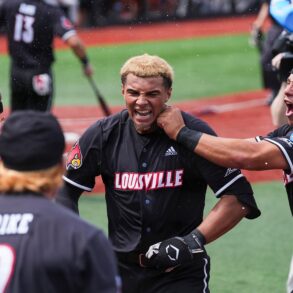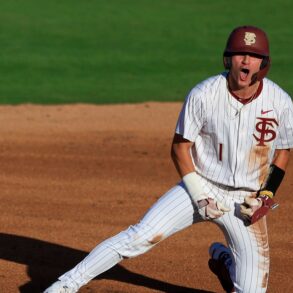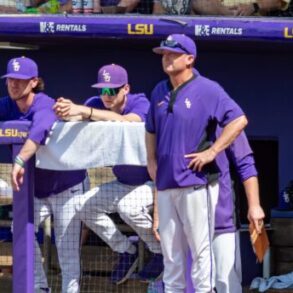
Image credit:
(Photo by Jay Biggerstaff/Getty Images)
For the first time since 1957, the men’s College World Series field won’t include a team making back-to-back appearances. It’s that kind of year—a bracket full of fresh faces, new storylines and wide-open possibilities.
It also marks the first time since 2014 that only one of the top five national seeds has reached Omaha, underscoring just how chaotic and balanced this postseason has been.
With Duke (ACC) and Murray State (Missouri Valley) still set to play for the final spot, the current field already spans five conferences: the SEC (2), ACC, Big 12, Big Ten and Sun Belt. Oregon State, meanwhile, becomes the first independent team to reach Omaha since Miami in 2004.
Below is a breakdown of the seven teams that have already earned a berth in Omaha. Teams are listed in their opening pods of four with each table reflecting opening matchups. Opponents are adjacent to each other.
| Coastal Carolina | Arizona |
| Louisville | Oregon State |
Coastal Carolina
Path To Omaha
The hottest team in the country rolled through regionals and supers, extending its win streak to 23 games and punching its first College World Series ticket since its miraculous 2016 national title run.
But make no mistake, Coastal’s push back to Omaha is no Cinderella story this time. If it wins it all, it should come as no surprise.
The Chanticleers have pitched to one of college baseball’s best team ERA’s this season and enter the final phase of the bracket at No. 3 in RPI and just two wins shy of the all-time program record, which was set back in 2010.
There were questions about whether or not Coastal was truly battle-tested entering the postseason, having faced the second-worst strength of schedule among regional hosts this year. But those concerns were quickly quelled when they breezed through regional play and handed Auburn a pair of swift losses to advance.
What’s Clicking
The easy answer here is everything. The Chanticleers are averaging eight runs per game in the postseason after averaging 7.5 in the regular season and their pitching has been as successful as advertised.
The arms are worth focusing on, though.
Cameron Flukey, Jacob Morrison and Riley Eikhoff form an elite rotation in which Flukey’s 3.24 ERA is the worst of the bunch. The trio is averaging 6.1 innings per start in the postseason, leaving less than a third of the game to a bullpen that primarily utilizes Ryan Lynch (0.59 ERA), Matthew Potok (2.55), Dominick Carbone (2.61), Darin Horn (2.96) and Hayden johnson (3.03). Charles Schwab Field plays kindly for pitchers even in the sport’s current offense-forward environment. Last year, College World Series teams averaged just 5.1 runs per game, opening the door for teams with strong pitching to dominate.
Question Marks
Coastal’s lineup wasn’t tested much against elite arms during the season. While it’s handled the postseason exceptionally well, it will be interesting to see what this unit does in Omaha, where hitting is a much taller task.
Until the postseason, the Chanticleers have relied much more on their ability to advance station to station than put the ball out of the yard, a characteristic that could very much play to their favor at Charles Schwab Field. But with pitching so strong, offense is the logical question mark.
Arizona
Path To Omaha
After a stunning 18-2 Game 1 loss in Chapel Hill, Arizona showed true grit to rally back and clinch dramatic 10-8 and 4-3 wins over North Carolina, sealing its 19th trip to the College World Series and first under coach Chip Hale.
Starter Smith Bailey delivered six steady innings in the clincher, while relievers Julian Tonghini, Casey Hintz and Tony Pluta combined for hitless relief.
Arizona enters Omaha justifying its reputation for resilience, having swept the Eugene Regional and rebounded impressively from adversity in supers.
What’s Clicking
This team thrives on the margins. Its bullpen has been elite, particularly Pluta, who has been nearly untouchable since April and notched his school-record 14th save.
Offensively, Mason White continues to spark the lineup, delivering key hits throughout the postseason—including the eighth-inning two-run single that flipped Game 3 in Chapel Hill.
With a balanced lineup built for situational hitting and a reliever-heavy pitching formula, Arizona is playing crisp, winning baseball that translates well to Omaha.
Question Marks
The starting rotation has been steady but lacks a true frontline ace. As the competition tightens in Omaha, the Wildcats may need more length from their starters or risk leaning too heavily on the bullpen. Whether that formula holds up against deeper, more dynamic lineups will be worth watching.
Louisville
Path To Omaha
Louisville is back in the College World Series for the first time since 2019 after navigating one of the most demanding roads in this year’s postseason.
The Cardinals opened in the Nashville Regional, where they stunned No. 1 overall seed Vanderbilt then ended a potential Cinderela bid to take the title. From there, they hosted an unexpected Super Regional against Miami, which upset host Southern Miss, and capitalized with a pair of wins to punch their ticket to Omaha after playing the maximum three games in the second round.
At 40 wins, this is one of Dan McDonnell’s deepest and most complete teams in recent years.
Louisville enters the College World Series with a balanced roster and postseason-tested core.
What’s Clicking
The pitching staff has taken center stage during the postseason run. Louisville’s starters have been consistently strong, while its bullpen has proven capable of closing out tight games—a welcomed change of events after the Cardinals entered the postseason with one of the more unsightly team ERAs in the field.
Offensively, the Cardinals have found their identity as a well-rounded, pressure-based group. They don’t rely solely on the long ball, but rather grind out at-bats, take advantage of scoring opportunities and force opponents into mistakes with an exceptionally low strikeout rate.
The team’s improved approach at the plate has been a big reason why it’s played so consistently in close games this postseason.
Question Marks
Can Louisville maintain its offensive consistency against the elite arms it will face in Omaha? While the Cardinals have scored enough to win close games, they haven’t been an overwhelming offense this postseason, averaging under six runs per game (5.7).
In a setting like Charles Schwab Field, where offense tends to be more situational and runs are at a premium, Louisville’s ability to create sustained pressure will be key. If the lineup can continue to produce timely hits and support the pitching staff, this team has the makeup to go deep.
Oregon State
Path To Omaha
Oregon State claimed its spot in Omaha for the first time since 2018, navigating a pair of dramatic weekends in Corvallis.
The Beavers handled an action-packed super regional against Oregon State that saw them win a tense extra-inning Game 1—capped by a ninth-inning rally and a 10-inning walk-off—and lose Game 2 before exploding for a 14–10 win in Game 3 to close it out. That decisive victory featured a seven-run first and a six-run third, showcasing the Beavers’ ability to strike early and decisively.
Their pitching was also outstanding in the first two games of super regional action with Dax Whitney and Ethan Kleinschmit combining to punch out 21 over 10.2 innings.
The Beavers advanced to Omaha after losing the one-four game to open regionals.
What’s Clicking
Whitney and Kleinschmit set the tone for a staff that has looked excellent lately, especially with its ability to miss bats, which will be critically important in Omaha.
Whitney has struck out 22 over his last 10.2 innings and Kleinschmit is rolling with 11 strikeouts in his most recent six-inning start.
Oregon States’ lineup, anchored by power outbursts, complemented that pitching dominance with massive run surges. The group’s ability to blow games open with big innings—and then trust their arms to hold leads—is a tested and balanced formula.
Question Marks
Can Oregon State’s offense stay aggressive without being foolish?
In Game 3, they traded fastball contact for fastball bombs—but that kind of hit parade is rare.
If games tighten in Omaha and their pitching holds serve, they’ll need the lineup to continue trusting counts and delivering situational hits. Prior to the postseason, it had a tendency to get too aggressive at times, causing strikeouts to balloon.
Power-oriented teams can get swallowed up by the confines of Charles Schwab Field and Oregon State will need to take measures to avoid that so as not to put too much weight on their ability to pitch through games.
| Arkansas | LSU |
| UCLA | Duke/Murray State |
Arkansas
Path To Omaha
As the country’s No. 3 overall seed, Arkansas validated all expectations by storming through the Fayetteville Regional and dominating Tennessee in a home super. The Razorbacks opened with a tense 4-3 win, riding a combined performance in which starter Zach Root and Gabe Gaeckle struck out eight and held the Vols to two hits.
That set the tone. In Game 2, a fourth-inning grand slam from Logan Maxwell triggered an 11-4 rout that closed out the series.
What’s Clicking
Arkansas is peaking in all the right ways.
The pitching staff has been razor sharp, led by Root and Gaeckle in the rotation and bullpen, respectively.
Offensively, the power comes in violent waves: with players like Wahiwa Aloy, Kuhio Aloy, Charles Davalan and others capable of breaking a game open with one swing. They don’t rely on overwhelming slugging, though, as this lineup understands how to navigate angels, place the ball in gaps and push runners station-to-station.
Question Marks
There are few here.
Arkansas pitches well, has a balanced offense and tested each of those areas against premium pitching and offenses in the SEC all season. The rotation and bullpen will need to continue to prove their dominance in Omaha, which likely provides the biggest question. But this team is the favorite.
LSU
Path To Omaha
Ranked No. 1 in Baseball America’s final in-season Top 25, LSU survived a regional-round scare against Little Rock that raised fair questions about its readiness to return to Omaha only to turn around and bludgeon West Virginia in a two-game super regional sweep that highlighted its prowess.
LSU uncorked 16-9 and 12-5 wins that looked more competitive on the scoreboard than they did during the games. Its offense was unrelenting with an ambushing approach that netted four home runs and 28 total runs in just two games while its pitching had the freedom to throw strikes and get outs, even if it came with some higher run totals allowed as a result.
What’s Clicking
LSU’s offense is a power-forward beast—one of the most dangerous lineups in the country when it finds a mistake to punish. This group lays waste to hittable pitches and stacks big innings in waves. It’s not just solo shots or isolated bursts; LSU sustains its run production with long, crushing innings that flip games in an instant. That pattern has defined the Tigers throughout the postseason.
Jared Jones, Derek Curiel, Steven Milam, Ethan Frey and Jake Brown are all swinging red-hot bats right now, giving LSU multiple threats in every pocket of the lineup. The Tigers torched West Virginia for six- and seven-run innings across both Super Regional games, showing exactly how explosive they can be when their approach locks in.
On the mound, things are clicking as well, particularly at the front of the rotation. Kade Anderson and Anthony Eyanson have been superb, attacking the zone with high-level stuff and giving LSU strong, stable starts. That one-two punch sets up the bullpen to close out games in favorable spots.
Question Marks
LSU hasn’t faced an extended stretch of elite, Omaha-caliber pitching this postseason—how will its offense respond when runs are harder to come by? The Tigers have thrived on big innings, but tighter CWS games may require more consistent, situational scoring. On the mound, rotation depth behind Anderson and Eyanson will also be tested in a longer bracket. If LSU can manage both, it’s built to win it all.
UCLA
Path To Omaha
UCLA has yet to be seriously tested this postseason. The Bruins swept their own regional, defeating UC Irvine, Arizona State and Fresno State once each to advance with minimal stress.
From there, they hosted UTSA in the Los Angeles Super Regional and breezed through with back-to-back wins, 5-2 and 7-0.
Across five postseason games, UCLA has outscored its opponents 50-16. This marks the program’s first College World Series trip since winning it all in 2013, and the path back has been controlled and convincing.
What’s Clicking
UCLA’s offense runs through a star-studded sophomore core that’s grown up fast.
Shortstop Roch Cholowsky, first baseman Mulivai Levu and third baseman Roman Martin have all been pivotal, producing consistently throughout the postseason. As a group, the Bruins’ offense handles velocity well, recognizes spin, and controls the strike zone at a high level.
They don’t chase much, strike out sparingly, and draw their share of walks—traits that play well in pressure games. While the lineup leans a bit more toward power than contact, its overall patience and approach should translate effectively in Omaha, even in a more difficult hitting environment.
Question Marks
The biggest variable is UCLA’s pitching staff, which has been inconsistent over the course of the season.
Even when successful, the staff is built more on pitching to contact than generating swing-and-miss, something that’s true in both the rotation and bullpen. The bullpen offers a bit more ability to miss bats, but it’s still less than many of the top teams remaining. Charles Schwab Field could help that approach with its spacious dimensions, but in the current high-offense era of college baseball, relying heavily on contact outs is a dangerous game.
How well UCLA navigates that balance will go a long way in determining how deep it can go.
This post was originally published on this site be sure to check out more of their content.





